HI6006 Strategy Development: Analyzing PESTEL, 5F, and RBV in Business
VerifiedAdded on 2023/06/12
|9
|1763
|395
Essay
AI Summary
This essay provides a comprehensive analysis of strategy development tools, focusing on PESTEL, Porter's Five Forces, and the Resource-Based View (RBV). It examines how these frameworks are applied in business, using Toyota as a case study to illustrate competitive strategy. The essay covers Toyota's core capabilities, emphasizing research and development, and explores external factors through Porter's Five Forces and PESTLE analyses. It concludes that integrating internal resource analysis with external market assessments is crucial for achieving a sustainable competitive advantage, recommending that companies balance RBV with frameworks like Porter's Five Forces and PESTEL to navigate market challenges effectively.
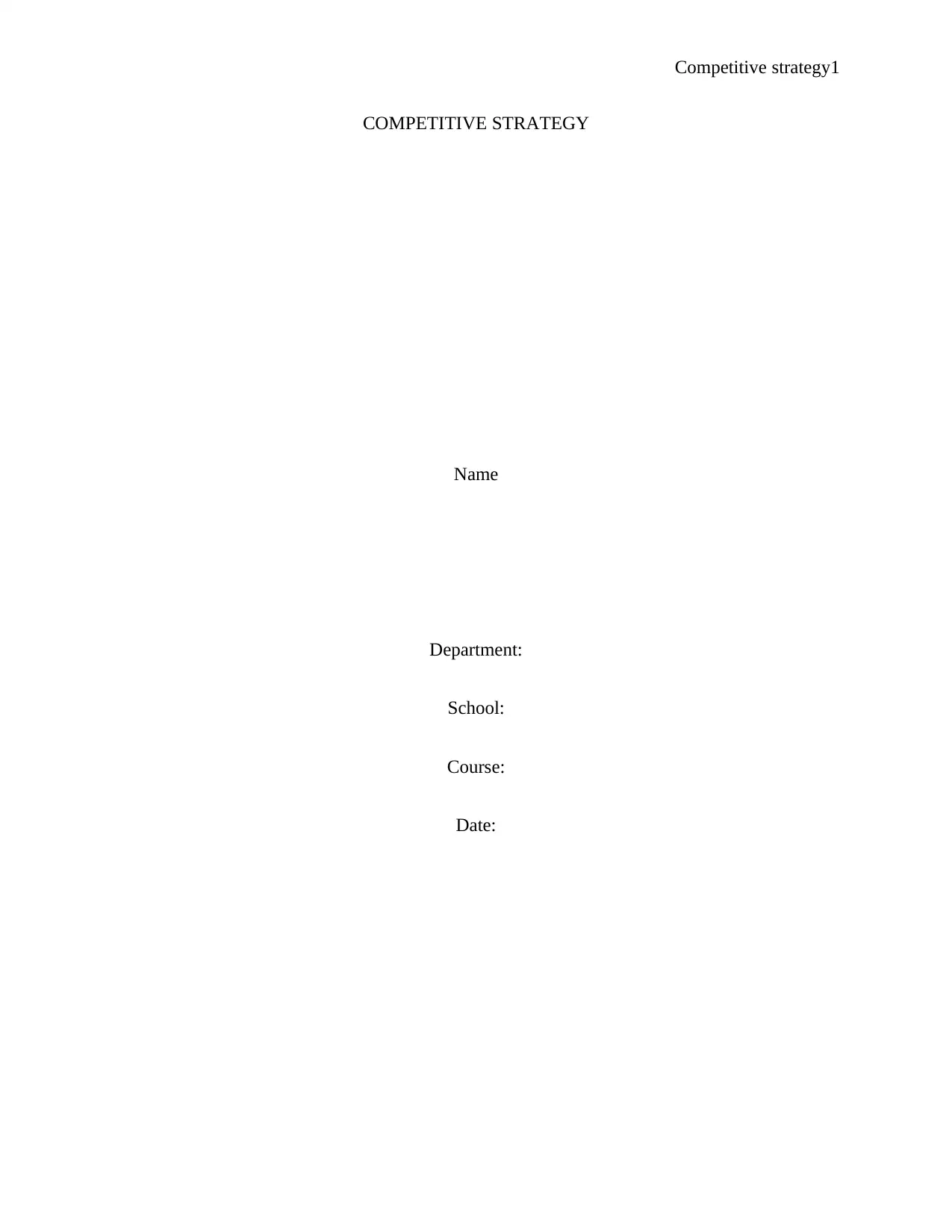
Competitive strategy1
COMPETITIVE STRATEGY
Name
Department:
School:
Course:
Date:
COMPETITIVE STRATEGY
Name
Department:
School:
Course:
Date:
Paraphrase This Document
Need a fresh take? Get an instant paraphrase of this document with our AI Paraphraser
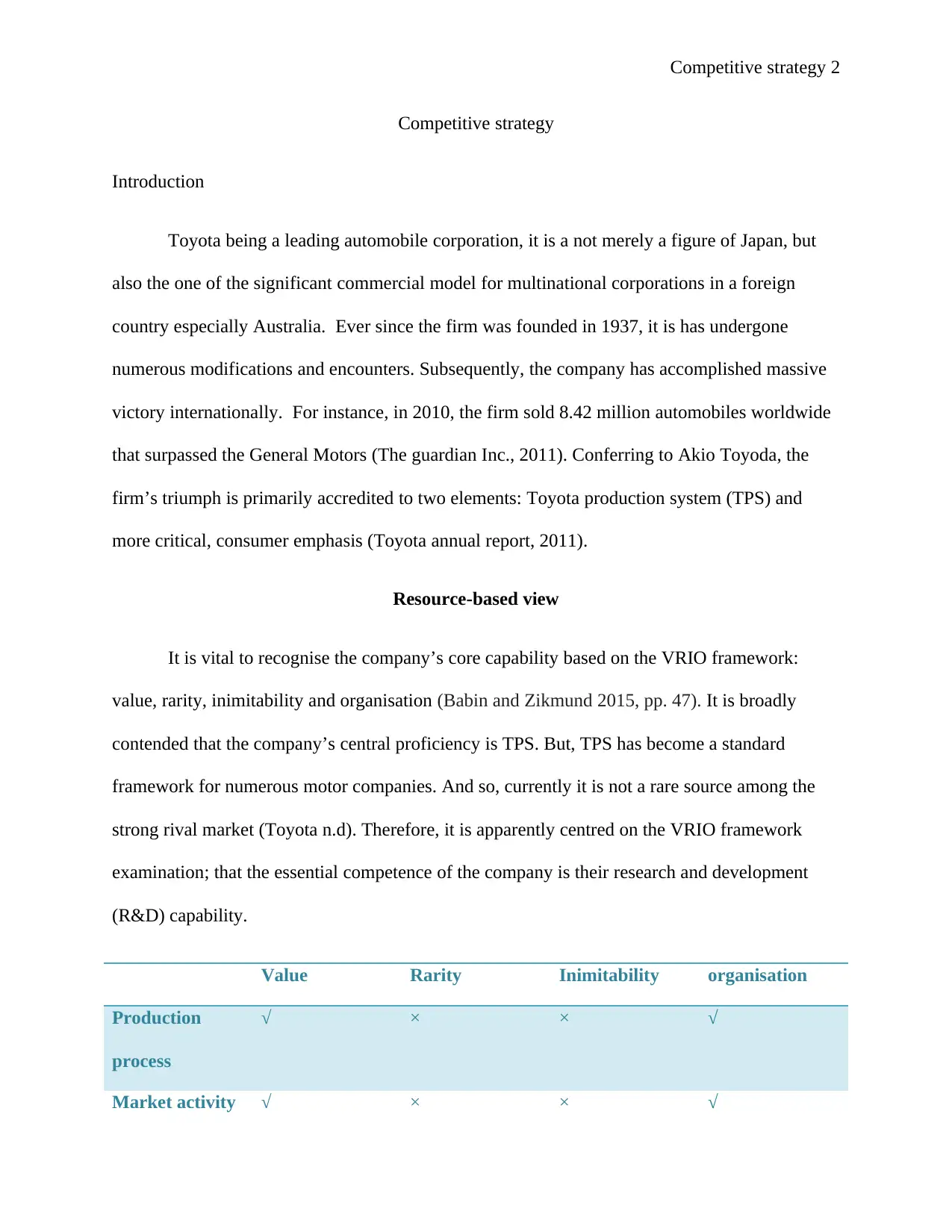
Competitive strategy 2
Competitive strategy
Introduction
Toyota being a leading automobile corporation, it is a not merely a figure of Japan, but
also the one of the significant commercial model for multinational corporations in a foreign
country especially Australia. Ever since the firm was founded in 1937, it is has undergone
numerous modifications and encounters. Subsequently, the company has accomplished massive
victory internationally. For instance, in 2010, the firm sold 8.42 million automobiles worldwide
that surpassed the General Motors (The guardian Inc., 2011). Conferring to Akio Toyoda, the
firm’s triumph is primarily accredited to two elements: Toyota production system (TPS) and
more critical, consumer emphasis (Toyota annual report, 2011).
Resource-based view
It is vital to recognise the company’s core capability based on the VRIO framework:
value, rarity, inimitability and organisation (Babin and Zikmund 2015, pp. 47). It is broadly
contended that the company’s central proficiency is TPS. But, TPS has become a standard
framework for numerous motor companies. And so, currently it is not a rare source among the
strong rival market (Toyota n.d). Therefore, it is apparently centred on the VRIO framework
examination; that the essential competence of the company is their research and development
(R&D) capability.
Value Rarity Inimitability organisation
Production
process
√ × × √
Market activity √ × × √
Competitive strategy
Introduction
Toyota being a leading automobile corporation, it is a not merely a figure of Japan, but
also the one of the significant commercial model for multinational corporations in a foreign
country especially Australia. Ever since the firm was founded in 1937, it is has undergone
numerous modifications and encounters. Subsequently, the company has accomplished massive
victory internationally. For instance, in 2010, the firm sold 8.42 million automobiles worldwide
that surpassed the General Motors (The guardian Inc., 2011). Conferring to Akio Toyoda, the
firm’s triumph is primarily accredited to two elements: Toyota production system (TPS) and
more critical, consumer emphasis (Toyota annual report, 2011).
Resource-based view
It is vital to recognise the company’s core capability based on the VRIO framework:
value, rarity, inimitability and organisation (Babin and Zikmund 2015, pp. 47). It is broadly
contended that the company’s central proficiency is TPS. But, TPS has become a standard
framework for numerous motor companies. And so, currently it is not a rare source among the
strong rival market (Toyota n.d). Therefore, it is apparently centred on the VRIO framework
examination; that the essential competence of the company is their research and development
(R&D) capability.
Value Rarity Inimitability organisation
Production
process
√ × × √
Market activity √ × × √
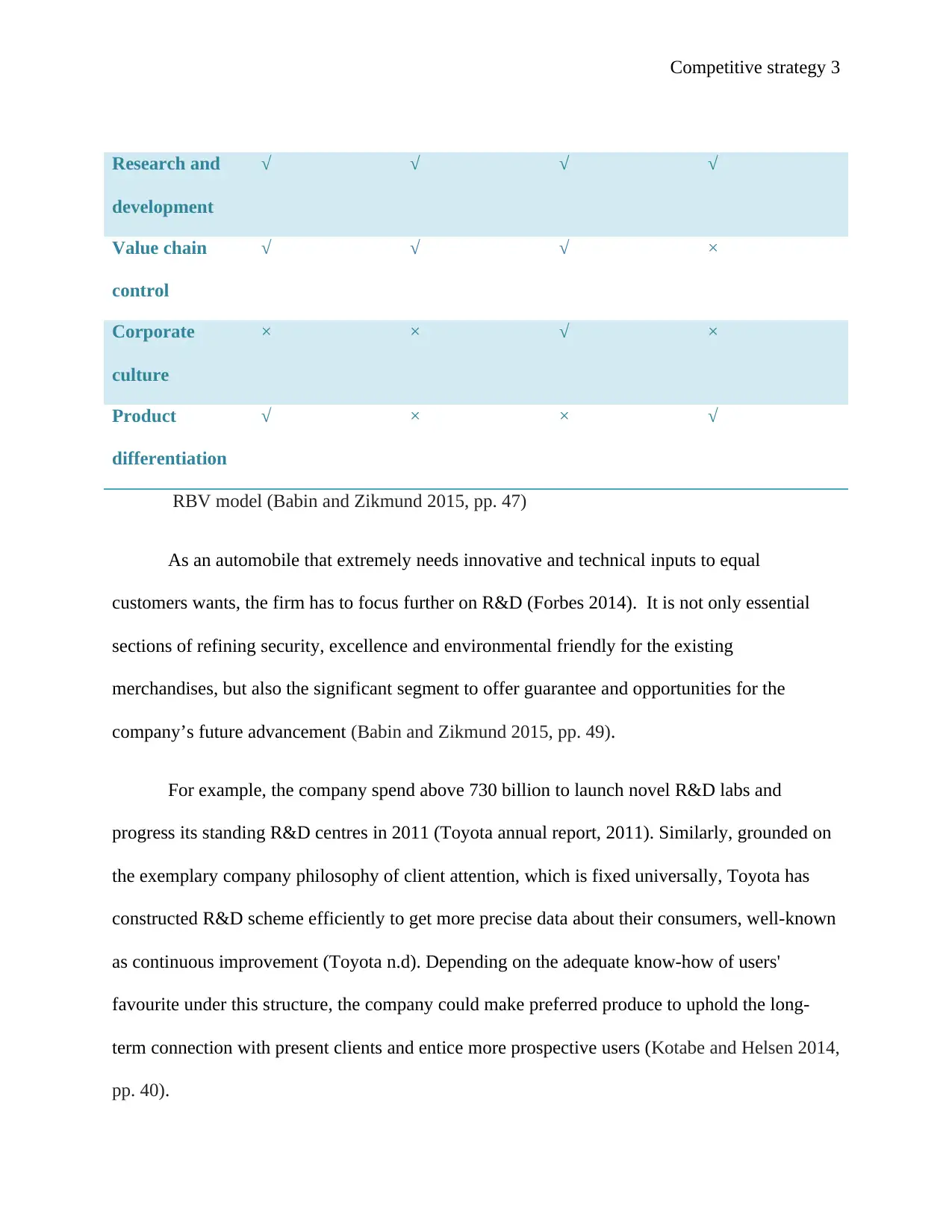
Competitive strategy 3
Research and
development
√ √ √ √
Value chain
control
√ √ √ ×
Corporate
culture
× × √ ×
Product
differentiation
√ × × √
RBV model (Babin and Zikmund 2015, pp. 47)
As an automobile that extremely needs innovative and technical inputs to equal
customers wants, the firm has to focus further on R&D (Forbes 2014). It is not only essential
sections of refining security, excellence and environmental friendly for the existing
merchandises, but also the significant segment to offer guarantee and opportunities for the
company’s future advancement (Babin and Zikmund 2015, pp. 49).
For example, the company spend above 730 billion to launch novel R&D labs and
progress its standing R&D centres in 2011 (Toyota annual report, 2011). Similarly, grounded on
the exemplary company philosophy of client attention, which is fixed universally, Toyota has
constructed R&D scheme efficiently to get more precise data about their consumers, well-known
as continuous improvement (Toyota n.d). Depending on the adequate know-how of users'
favourite under this structure, the company could make preferred produce to uphold the long-
term connection with present clients and entice more prospective users (Kotabe and Helsen 2014,
pp. 40).
Research and
development
√ √ √ √
Value chain
control
√ √ √ ×
Corporate
culture
× × √ ×
Product
differentiation
√ × × √
RBV model (Babin and Zikmund 2015, pp. 47)
As an automobile that extremely needs innovative and technical inputs to equal
customers wants, the firm has to focus further on R&D (Forbes 2014). It is not only essential
sections of refining security, excellence and environmental friendly for the existing
merchandises, but also the significant segment to offer guarantee and opportunities for the
company’s future advancement (Babin and Zikmund 2015, pp. 49).
For example, the company spend above 730 billion to launch novel R&D labs and
progress its standing R&D centres in 2011 (Toyota annual report, 2011). Similarly, grounded on
the exemplary company philosophy of client attention, which is fixed universally, Toyota has
constructed R&D scheme efficiently to get more precise data about their consumers, well-known
as continuous improvement (Toyota n.d). Depending on the adequate know-how of users'
favourite under this structure, the company could make preferred produce to uphold the long-
term connection with present clients and entice more prospective users (Kotabe and Helsen 2014,
pp. 40).
⊘ This is a preview!⊘
Do you want full access?
Subscribe today to unlock all pages.

Trusted by 1+ million students worldwide
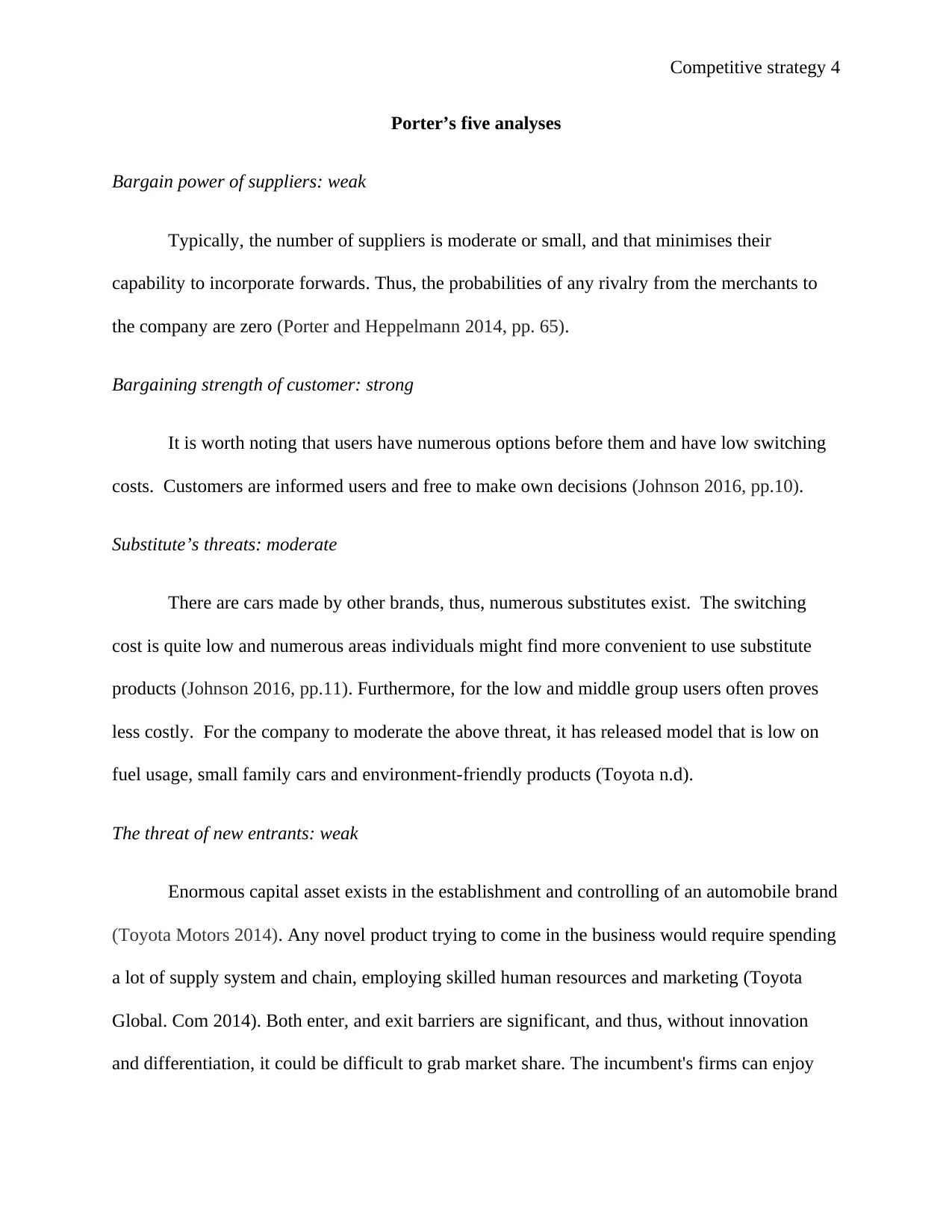
Competitive strategy 4
Porter’s five analyses
Bargain power of suppliers: weak
Typically, the number of suppliers is moderate or small, and that minimises their
capability to incorporate forwards. Thus, the probabilities of any rivalry from the merchants to
the company are zero (Porter and Heppelmann 2014, pp. 65).
Bargaining strength of customer: strong
It is worth noting that users have numerous options before them and have low switching
costs. Customers are informed users and free to make own decisions (Johnson 2016, pp.10).
Substitute’s threats: moderate
There are cars made by other brands, thus, numerous substitutes exist. The switching
cost is quite low and numerous areas individuals might find more convenient to use substitute
products (Johnson 2016, pp.11). Furthermore, for the low and middle group users often proves
less costly. For the company to moderate the above threat, it has released model that is low on
fuel usage, small family cars and environment-friendly products (Toyota n.d).
The threat of new entrants: weak
Enormous capital asset exists in the establishment and controlling of an automobile brand
(Toyota Motors 2014). Any novel product trying to come in the business would require spending
a lot of supply system and chain, employing skilled human resources and marketing (Toyota
Global. Com 2014). Both enter, and exit barriers are significant, and thus, without innovation
and differentiation, it could be difficult to grab market share. The incumbent's firms can enjoy
Porter’s five analyses
Bargain power of suppliers: weak
Typically, the number of suppliers is moderate or small, and that minimises their
capability to incorporate forwards. Thus, the probabilities of any rivalry from the merchants to
the company are zero (Porter and Heppelmann 2014, pp. 65).
Bargaining strength of customer: strong
It is worth noting that users have numerous options before them and have low switching
costs. Customers are informed users and free to make own decisions (Johnson 2016, pp.10).
Substitute’s threats: moderate
There are cars made by other brands, thus, numerous substitutes exist. The switching
cost is quite low and numerous areas individuals might find more convenient to use substitute
products (Johnson 2016, pp.11). Furthermore, for the low and middle group users often proves
less costly. For the company to moderate the above threat, it has released model that is low on
fuel usage, small family cars and environment-friendly products (Toyota n.d).
The threat of new entrants: weak
Enormous capital asset exists in the establishment and controlling of an automobile brand
(Toyota Motors 2014). Any novel product trying to come in the business would require spending
a lot of supply system and chain, employing skilled human resources and marketing (Toyota
Global. Com 2014). Both enter, and exit barriers are significant, and thus, without innovation
and differentiation, it could be difficult to grab market share. The incumbent's firms can enjoy
Paraphrase This Document
Need a fresh take? Get an instant paraphrase of this document with our AI Paraphraser
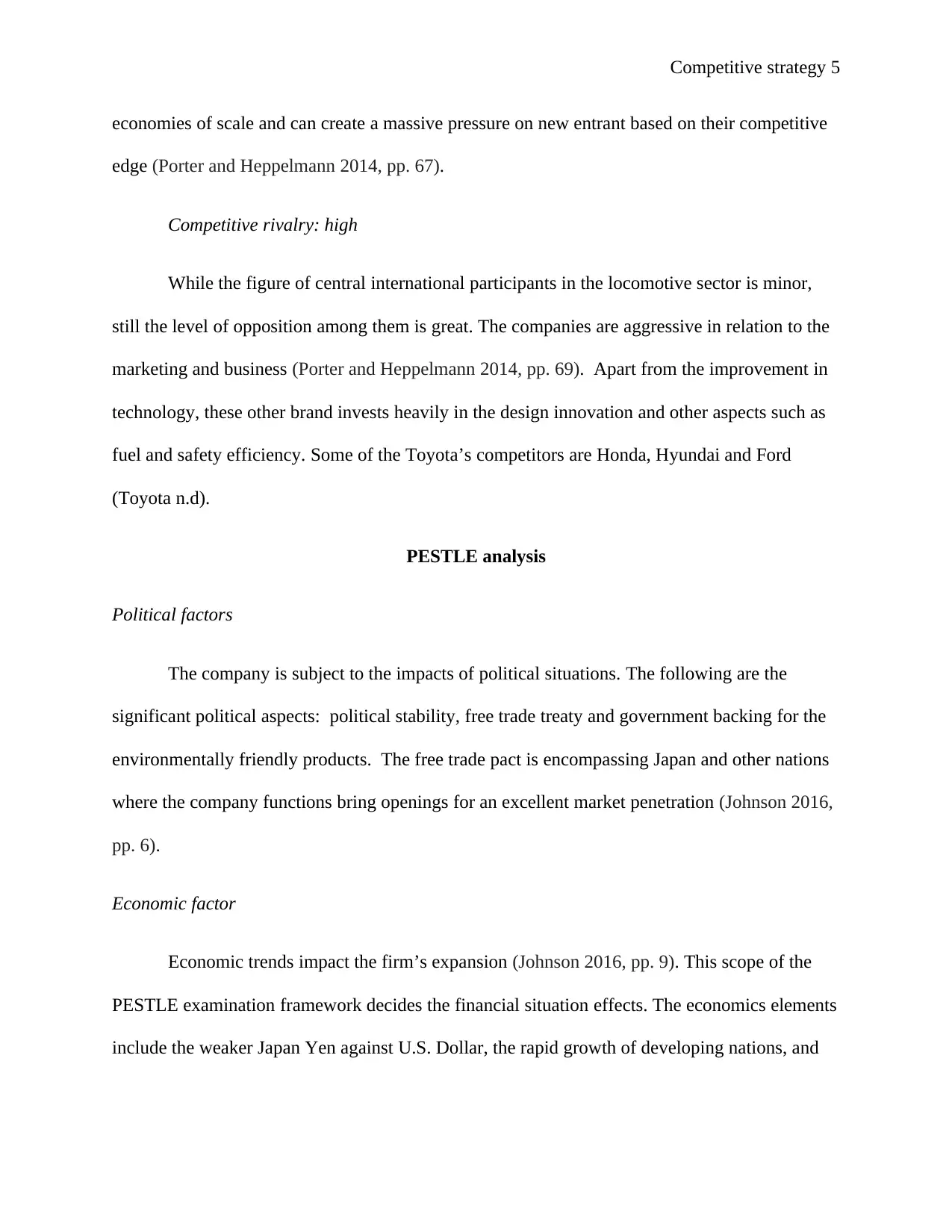
Competitive strategy 5
economies of scale and can create a massive pressure on new entrant based on their competitive
edge (Porter and Heppelmann 2014, pp. 67).
Competitive rivalry: high
While the figure of central international participants in the locomotive sector is minor,
still the level of opposition among them is great. The companies are aggressive in relation to the
marketing and business (Porter and Heppelmann 2014, pp. 69). Apart from the improvement in
technology, these other brand invests heavily in the design innovation and other aspects such as
fuel and safety efficiency. Some of the Toyota’s competitors are Honda, Hyundai and Ford
(Toyota n.d).
PESTLE analysis
Political factors
The company is subject to the impacts of political situations. The following are the
significant political aspects: political stability, free trade treaty and government backing for the
environmentally friendly products. The free trade pact is encompassing Japan and other nations
where the company functions bring openings for an excellent market penetration (Johnson 2016,
pp. 6).
Economic factor
Economic trends impact the firm’s expansion (Johnson 2016, pp. 9). This scope of the
PESTLE examination framework decides the financial situation effects. The economics elements
include the weaker Japan Yen against U.S. Dollar, the rapid growth of developing nations, and
economies of scale and can create a massive pressure on new entrant based on their competitive
edge (Porter and Heppelmann 2014, pp. 67).
Competitive rivalry: high
While the figure of central international participants in the locomotive sector is minor,
still the level of opposition among them is great. The companies are aggressive in relation to the
marketing and business (Porter and Heppelmann 2014, pp. 69). Apart from the improvement in
technology, these other brand invests heavily in the design innovation and other aspects such as
fuel and safety efficiency. Some of the Toyota’s competitors are Honda, Hyundai and Ford
(Toyota n.d).
PESTLE analysis
Political factors
The company is subject to the impacts of political situations. The following are the
significant political aspects: political stability, free trade treaty and government backing for the
environmentally friendly products. The free trade pact is encompassing Japan and other nations
where the company functions bring openings for an excellent market penetration (Johnson 2016,
pp. 6).
Economic factor
Economic trends impact the firm’s expansion (Johnson 2016, pp. 9). This scope of the
PESTLE examination framework decides the financial situation effects. The economics elements
include the weaker Japan Yen against U.S. Dollar, the rapid growth of developing nations, and
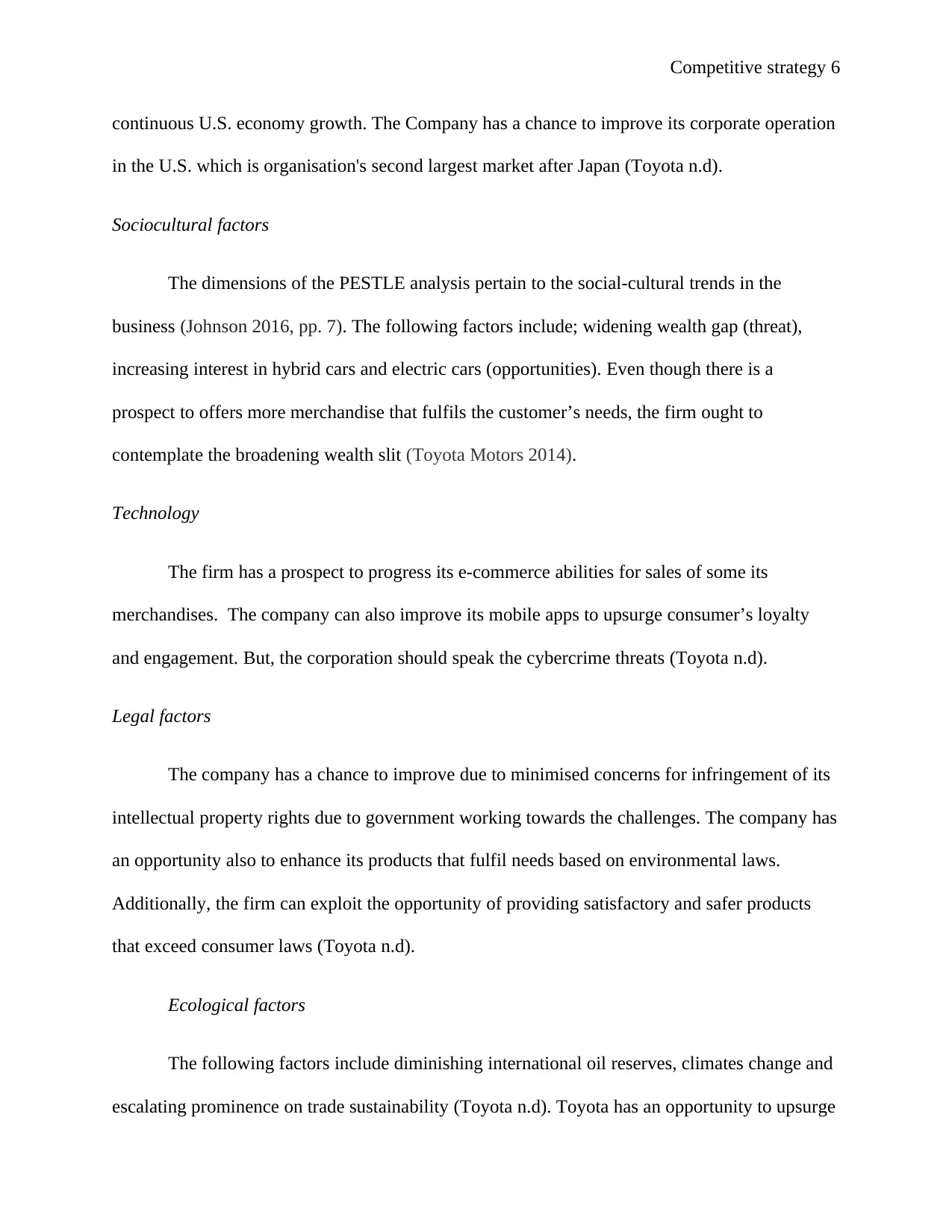
Competitive strategy 6
continuous U.S. economy growth. The Company has a chance to improve its corporate operation
in the U.S. which is organisation's second largest market after Japan (Toyota n.d).
Sociocultural factors
The dimensions of the PESTLE analysis pertain to the social-cultural trends in the
business (Johnson 2016, pp. 7). The following factors include; widening wealth gap (threat),
increasing interest in hybrid cars and electric cars (opportunities). Even though there is a
prospect to offers more merchandise that fulfils the customer’s needs, the firm ought to
contemplate the broadening wealth slit (Toyota Motors 2014).
Technology
The firm has a prospect to progress its e-commerce abilities for sales of some its
merchandises. The company can also improve its mobile apps to upsurge consumer’s loyalty
and engagement. But, the corporation should speak the cybercrime threats (Toyota n.d).
Legal factors
The company has a chance to improve due to minimised concerns for infringement of its
intellectual property rights due to government working towards the challenges. The company has
an opportunity also to enhance its products that fulfil needs based on environmental laws.
Additionally, the firm can exploit the opportunity of providing satisfactory and safer products
that exceed consumer laws (Toyota n.d).
Ecological factors
The following factors include diminishing international oil reserves, climates change and
escalating prominence on trade sustainability (Toyota n.d). Toyota has an opportunity to upsurge
continuous U.S. economy growth. The Company has a chance to improve its corporate operation
in the U.S. which is organisation's second largest market after Japan (Toyota n.d).
Sociocultural factors
The dimensions of the PESTLE analysis pertain to the social-cultural trends in the
business (Johnson 2016, pp. 7). The following factors include; widening wealth gap (threat),
increasing interest in hybrid cars and electric cars (opportunities). Even though there is a
prospect to offers more merchandise that fulfils the customer’s needs, the firm ought to
contemplate the broadening wealth slit (Toyota Motors 2014).
Technology
The firm has a prospect to progress its e-commerce abilities for sales of some its
merchandises. The company can also improve its mobile apps to upsurge consumer’s loyalty
and engagement. But, the corporation should speak the cybercrime threats (Toyota n.d).
Legal factors
The company has a chance to improve due to minimised concerns for infringement of its
intellectual property rights due to government working towards the challenges. The company has
an opportunity also to enhance its products that fulfil needs based on environmental laws.
Additionally, the firm can exploit the opportunity of providing satisfactory and safer products
that exceed consumer laws (Toyota n.d).
Ecological factors
The following factors include diminishing international oil reserves, climates change and
escalating prominence on trade sustainability (Toyota n.d). Toyota has an opportunity to upsurge
⊘ This is a preview!⊘
Do you want full access?
Subscribe today to unlock all pages.

Trusted by 1+ million students worldwide
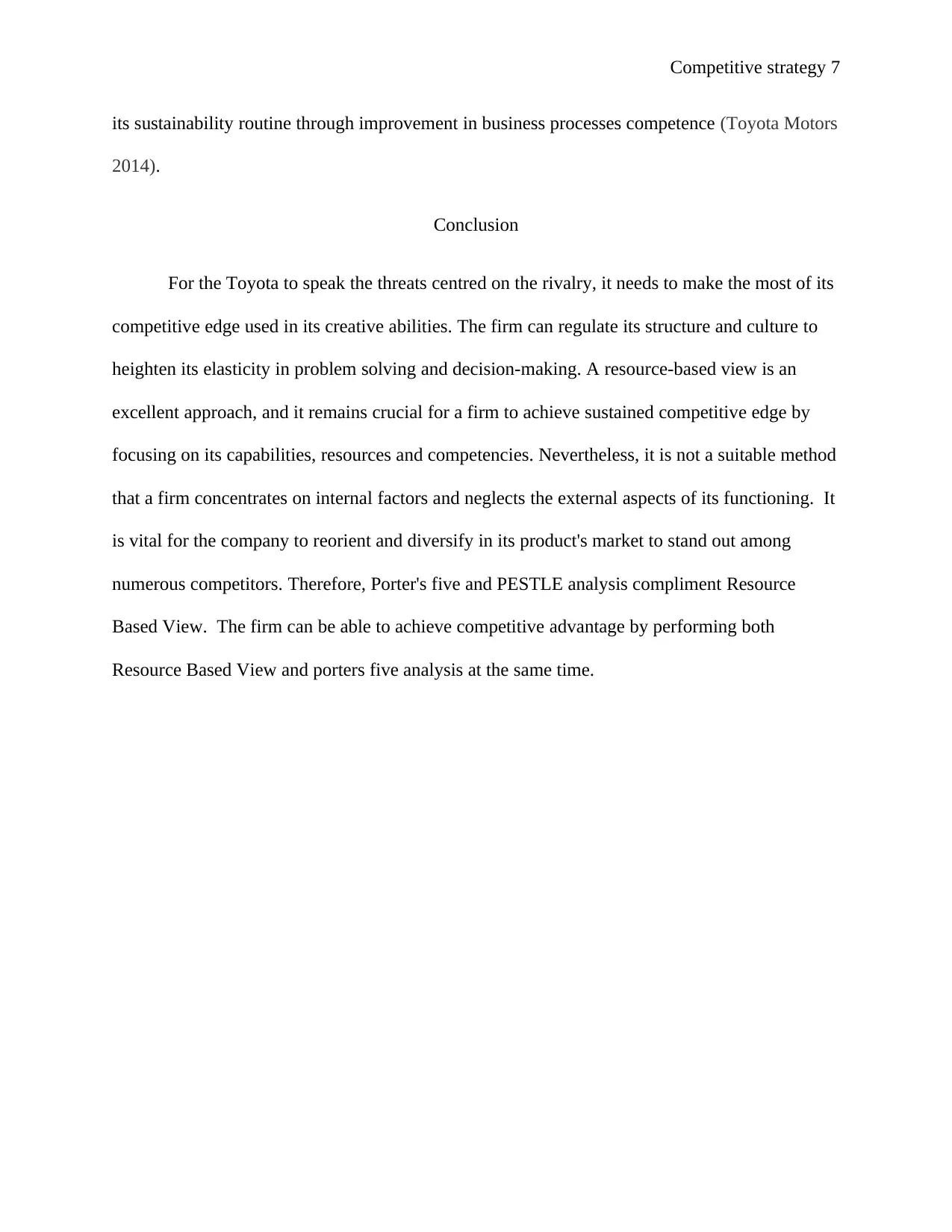
Competitive strategy 7
its sustainability routine through improvement in business processes competence (Toyota Motors
2014).
Conclusion
For the Toyota to speak the threats centred on the rivalry, it needs to make the most of its
competitive edge used in its creative abilities. The firm can regulate its structure and culture to
heighten its elasticity in problem solving and decision-making. A resource-based view is an
excellent approach, and it remains crucial for a firm to achieve sustained competitive edge by
focusing on its capabilities, resources and competencies. Nevertheless, it is not a suitable method
that a firm concentrates on internal factors and neglects the external aspects of its functioning. It
is vital for the company to reorient and diversify in its product's market to stand out among
numerous competitors. Therefore, Porter's five and PESTLE analysis compliment Resource
Based View. The firm can be able to achieve competitive advantage by performing both
Resource Based View and porters five analysis at the same time.
its sustainability routine through improvement in business processes competence (Toyota Motors
2014).
Conclusion
For the Toyota to speak the threats centred on the rivalry, it needs to make the most of its
competitive edge used in its creative abilities. The firm can regulate its structure and culture to
heighten its elasticity in problem solving and decision-making. A resource-based view is an
excellent approach, and it remains crucial for a firm to achieve sustained competitive edge by
focusing on its capabilities, resources and competencies. Nevertheless, it is not a suitable method
that a firm concentrates on internal factors and neglects the external aspects of its functioning. It
is vital for the company to reorient and diversify in its product's market to stand out among
numerous competitors. Therefore, Porter's five and PESTLE analysis compliment Resource
Based View. The firm can be able to achieve competitive advantage by performing both
Resource Based View and porters five analysis at the same time.
Paraphrase This Document
Need a fresh take? Get an instant paraphrase of this document with our AI Paraphraser
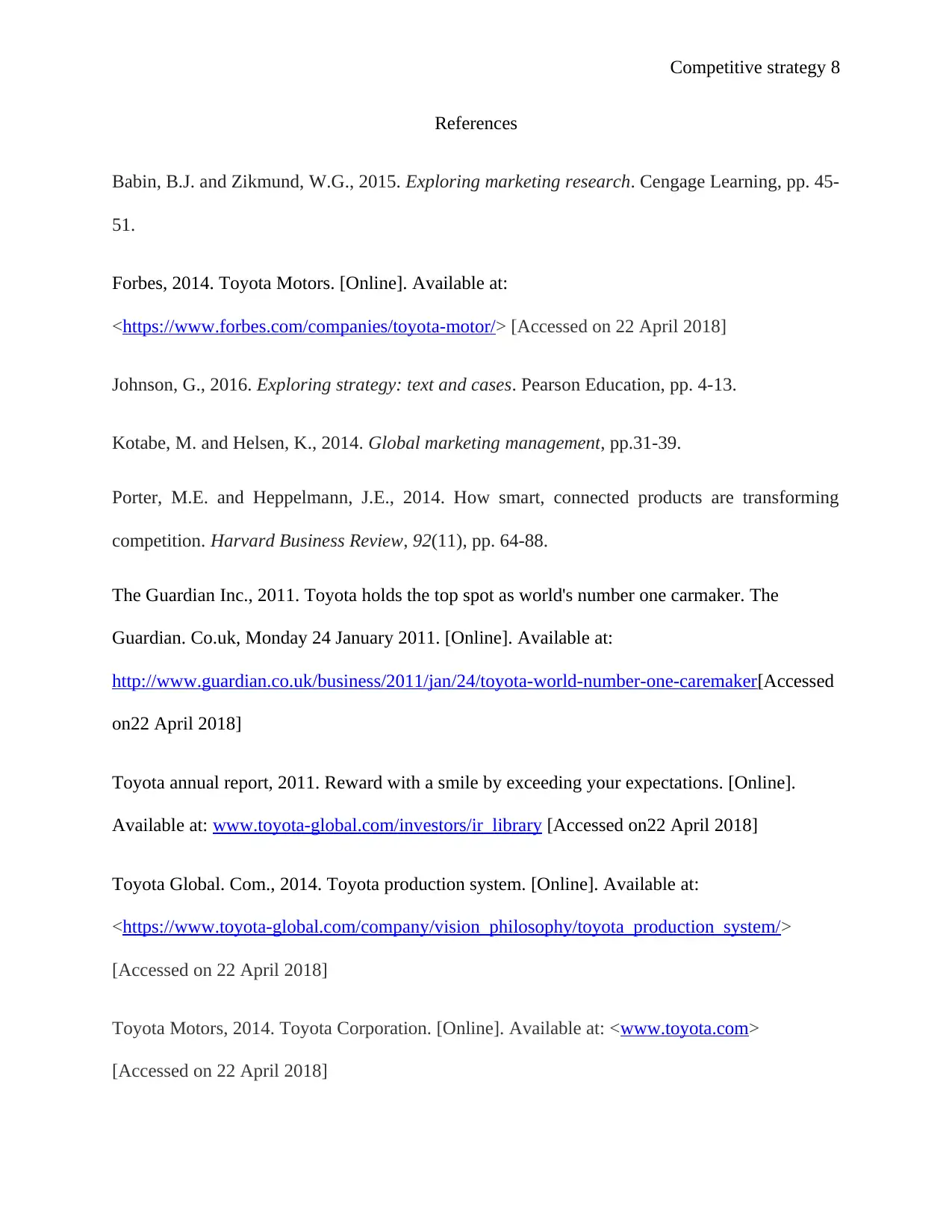
Competitive strategy 8
References
Babin, B.J. and Zikmund, W.G., 2015. Exploring marketing research. Cengage Learning, pp. 45-
51.
Forbes, 2014. Toyota Motors. [Online]. Available at:
<https://www.forbes.com/companies/toyota-motor/> [Accessed on 22 April 2018]
Johnson, G., 2016. Exploring strategy: text and cases. Pearson Education, pp. 4-13.
Kotabe, M. and Helsen, K., 2014. Global marketing management, pp.31-39.
Porter, M.E. and Heppelmann, J.E., 2014. How smart, connected products are transforming
competition. Harvard Business Review, 92(11), pp. 64-88.
The Guardian Inc., 2011. Toyota holds the top spot as world's number one carmaker. The
Guardian. Co.uk, Monday 24 January 2011. [Online]. Available at:
http://www.guardian.co.uk/business/2011/jan/24/toyota-world-number-one-caremaker[Accessed
on22 April 2018]
Toyota annual report, 2011. Reward with a smile by exceeding your expectations. [Online].
Available at: www.toyota-global.com/investors/ir_library [Accessed on22 April 2018]
Toyota Global. Com., 2014. Toyota production system. [Online]. Available at:
<https://www.toyota-global.com/company/vision_philosophy/toyota_production_system/>
[Accessed on 22 April 2018]
Toyota Motors, 2014. Toyota Corporation. [Online]. Available at: <www.toyota.com>
[Accessed on 22 April 2018]
References
Babin, B.J. and Zikmund, W.G., 2015. Exploring marketing research. Cengage Learning, pp. 45-
51.
Forbes, 2014. Toyota Motors. [Online]. Available at:
<https://www.forbes.com/companies/toyota-motor/> [Accessed on 22 April 2018]
Johnson, G., 2016. Exploring strategy: text and cases. Pearson Education, pp. 4-13.
Kotabe, M. and Helsen, K., 2014. Global marketing management, pp.31-39.
Porter, M.E. and Heppelmann, J.E., 2014. How smart, connected products are transforming
competition. Harvard Business Review, 92(11), pp. 64-88.
The Guardian Inc., 2011. Toyota holds the top spot as world's number one carmaker. The
Guardian. Co.uk, Monday 24 January 2011. [Online]. Available at:
http://www.guardian.co.uk/business/2011/jan/24/toyota-world-number-one-caremaker[Accessed
on22 April 2018]
Toyota annual report, 2011. Reward with a smile by exceeding your expectations. [Online].
Available at: www.toyota-global.com/investors/ir_library [Accessed on22 April 2018]
Toyota Global. Com., 2014. Toyota production system. [Online]. Available at:
<https://www.toyota-global.com/company/vision_philosophy/toyota_production_system/>
[Accessed on 22 April 2018]
Toyota Motors, 2014. Toyota Corporation. [Online]. Available at: <www.toyota.com>
[Accessed on 22 April 2018]
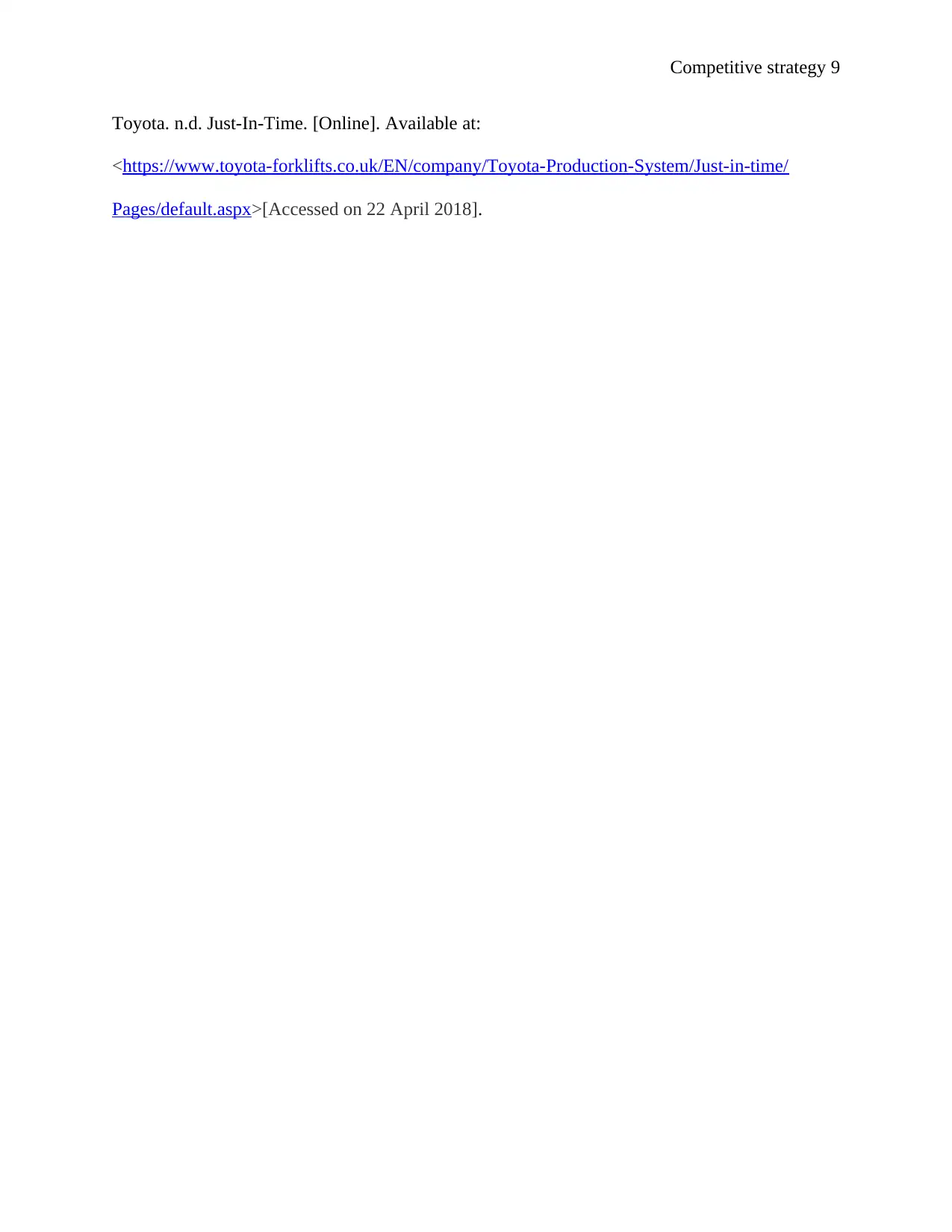
Competitive strategy 9
Toyota. n.d. Just-In-Time. [Online]. Available at:
<https://www.toyota-forklifts.co.uk/EN/company/Toyota-Production-System/Just-in-time/
Pages/default.aspx>[Accessed on 22 April 2018].
Toyota. n.d. Just-In-Time. [Online]. Available at:
<https://www.toyota-forklifts.co.uk/EN/company/Toyota-Production-System/Just-in-time/
Pages/default.aspx>[Accessed on 22 April 2018].
⊘ This is a preview!⊘
Do you want full access?
Subscribe today to unlock all pages.

Trusted by 1+ million students worldwide
1 out of 9
Your All-in-One AI-Powered Toolkit for Academic Success.
+13062052269
info@desklib.com
Available 24*7 on WhatsApp / Email
![[object Object]](/_next/static/media/star-bottom.7253800d.svg)
Unlock your academic potential
Copyright © 2020–2025 A2Z Services. All Rights Reserved. Developed and managed by ZUCOL.
